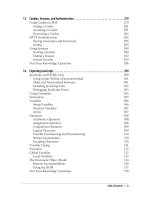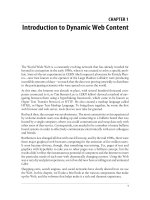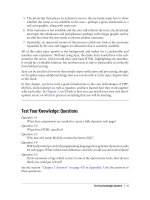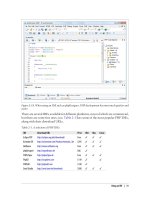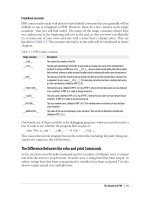Học php, mysql và javascript - p 2 docx
Bạn đang xem bản rút gọn của tài liệu. Xem và tải ngay bản đầy đủ của tài liệu tại đây (953.52 KB, 10 trang )
13. Cookies, Sessions, and Authentication . . . . . . . . . . . . . . . . . . . . . . . . . . . . . . . . . . . . 279
Using Cookies in PHP 279
Setting a Cookie 281
Accessing a Cookie 281
Destroying a Cookie 282
HTTP Authentication 282
Storing Usernames and Passwords 285
Salting 285
Using Sessions 289
Starting a Session 289
Ending a Session 292
Session Security 293
Test Your Knowledge: Questions 296
14. Exploring JavaScript . . .
. . . . . . . . . . . . . . . . . . . . . . . . . . . . . . . . . . . . . . . . . . . . . . . . 299
JavaScript and HTML Text 299
Using Scripts Within a Document Head 301
Older and Nonstandard Browsers 301
Including JavaScript Files 302
Debugging JavaScript Errors 303
Using Comments 305
Semicolons 305
Variables 306
String Variables 306
Numeric Variables 307
Arrays 307
Operators 308
Arithmetic Operators 308
Assignment Operators 308
Comparison Operators 309
Logical Operators 309
Variable Incrementing and Decrementing 310
String Concatenation 310
Escaping Characters 310
Variable Typing 311
Functions 312
Global Variables 312
Local Variables 312
The Document Object Model 314
Browser Incompatibilities 316
Using the DOM 317
Test Your Knowledge: Questions 318
Table of Contents | ix
15. Expressions and Control Flow in JavaScript . . . . . . . . . . . . . . . . . . . . . . . . . . . . . . . . 319
Expressions 319
Literals and Variables 320
Operators 321
Operator Precedence 321
Associativity 322
Relational Operators 323
The with Statement 325
Using onError 326
Using try catch 327
Conditionals 328
The if Statement 328
The switch Statement 329
The ? Operator 331
Looping 331
while Loops 331
do while Loops 332
for Loops 332
Breaking Out of a Loop 333
The continue Statement 334
Explicit Casting 334
Test Your Knowledge: Questions 335
16. JavaScript Functions, Objects, and Arrays . . .
. . . . . . . . . . . . . . . . . . . . . . . . . . . . . . 337
JavaScript Functions 337
Defining a Function 337
Returning a Value 339
Returning an Array 341
JavaScript Objects 341
Declaring a Class 341
Creating an Object 343
Accessing Objects 343
The prototype Keyword 344
JavaScript Arrays 346
Numeric Arrays 346
Associative Arrays 347
Multidimensional Arrays 348
Using Array Methods 349
Test Your Knowledge: Questions 353
17. JavaScript and PHP Validation and Error Handling . . .
. . . . . . . . . . . . . . . . . . . . . . . 355
Validating User Input with JavaScript 355
The validate.html Document (Part One) 356
x | Table of Contents
The validate.html Document (Part Two) 358
Regular Expressions 361
Matching Through Metacharacters 361
Fuzzy Character Matching 362
Grouping Through Parentheses 363
Character Classes 363
Indicating a Range 364
Negation 364
Some More Complicated Examples 364
Summary of Metacharacters 367
General Modifiers 369
Using Regular Expressions in JavaScript 369
Using Regular Expressions in PHP 369
Redisplaying a Form After PHP Validation 370
Test Your Knowledge: Questions 375
18. Using Ajax . . . . . . . . . . . . . . . . . . . . . . . . . . . . . . . . . . . . . . . . . . . . . . . . . . . . . . . . . . . 377
What Is Ajax? 378
Using XMLHttpRequest 378
Your First Ajax Program 380
Using GET Instead of POST 385
Sending XML Requests 387
Test Your Knowledge: Questions 391
19. Using YUI for Ajax and More
. . .
. . . . . . . . . . . . . . . . . . . . . . . . . . . . . . . . . . . . . . . . . 393
Choosing a Framework 393
Using YUI 394
Compressed Versions 396
Using YUI for Ajax 396
Other Uses for YUI 400
A Simple YUI Calendar 401
Test Your Knowledge: Questions 403
20. Bringing It All Together . . . . . . . . . . . . . . . . . . . . . . . . . . . . . . . . . . . . . . . . . . . . . . . . 405
Designing a Social Networking Site 405
About Third-Party Add-Ons 406
On the Website 406
rnfunctions.php 406
The Functions 407
rnheader.php 409
rnsetup.php 410
index.php 411
rnsignup.php 412
Table of Contents | xi
Checking for Username Availability 412
rnsignup.php (YUI version) 415
rncheckuser.php 417
rnlogin.php 417
rnprofile.php 419
Adding the “About Me” Text 420
Adding a Profile Image 420
Processing the Image 420
Displaying the Current Profile 421
rnmembers.php 424
Viewing a User’s Profile 424
Adding and Dropping Friends 424
Listing All Members 424
rnfriends.php 427
rnmessages.php 430
rnlogout.php 432
A. Solutions to the Chapter Questions . . .
. . . . . . . . . . . . . . . . . . . . . . . . . . . . . . . . . . . 435
B. Online Resources . . . . . . . . . . . . . . . . . . . . . . . . . . . . . . . . . . . . . . . . . . . . . . . . . . . . . 453
C. MySQL’s FULLTEXT Stopwords . . .
. . . . . . . . . . . . . . . . . . . . . . . . . . . . . . . . . . . . . . . . 457
D. MySQL Functions . . .
. . . . . . . . . . . . . . . . . . . . . . . . . . . . . . . . . . . . . . . . . . . . . . . . . . . 461
E. Using PEAR and PHPUnit . . . . . . . . . . . . . . . . . . . . . . . . . . . . . . . . . . . . . . . . . . . . . . . 473
Index . . . . . . . . . . . . . . . . . . . . . . . . . . . . . . . . . . . . . . . . . . . . . . . . . . . . . . . . . . . . . . . . . . . . . 485
xii | Table of Contents
Preface
The combination of PHP and MySQL is the most convenient approach to dynamic,
database-driven web design, holding its own in the face of challenges from integrated
frameworks—such as Ruby on Rails—that are harder to learn. Due to its open source
roots (unlike the competing Microsoft .NET framework), it is free to implement and is
therefore an extremely popular option for web development.
Any would-be developer on a Unix/Linux or even a Windows/Apache platform will
need to master these technologies. At the same time, the JavaScript is important, as it
provides the hidden communication with the web server to create seamless interfaces.
Audience
This book is for people who wish to learn how to create effective and dynamic websites.
This may include webmasters or graphic designers who are already creating static web-
sites but wish to take their skills to the next level as well as high school and college
students, recent graduates, and self-taught individuals.
In fact, anyone ready to learn the fundamentals behind the Web 2.0 technology known
as Ajax will obtain a thorough grounding in all three of the core technologies: PHP,
MySQL, and JavaScript.
Assumptions This Book Makes
This book assumes that you have a basic understanding of HTML and can at least put
together a simple, static website, but does not assume that you have any prior knowl-
edge of PHP, MySQL, or JavaScript—although if you do, your progress through the
book will be even quicker.
xiii
Organization of This Book
The chapters in this book are written in a specific order, first introducing all three of
the core technologies it covers and then walking you through their installation on a
web development server, so that you will be ready to work through the examples.
In the following section, you will gain a grounding in the PHP programming language,
covering the basics of syntax, arrays, functions, and object-oriented programming.
Then, with PHP under your belt, you will move on to an introduction to the MySQL
database system, where you will learn everything from how MySQL databases are
structured up to generating complex queries.
After that, you will learn how you can combine PHP and MySQL to start creating your
own dynamic web pages by integrating forms and other HTML features. You will then
spend some time looking at ways to speed up your web development using Smarty
templates.
In the next three chapters, you will get down to the nitty-gritty practical aspects of PHP
and MySQL development by learning a variety of useful functions and how to manage
cookies and sessions, as well as how to maintain a high level of security.
In the following four chapters, you will gain a thorough grounding in JavaScript, from
simple functions and event handling to accessing the Document Object Model and in-
browser validation and error handling.
With an understanding of all three of these core technologies, you will then learn how
to make behind-the-scenes Ajax calls and turn your websites into highly dynamic
environments.
Finally, you’ll put together everything you’ve learned in a complete set of PHP programs
that together constitute a fully working social networking website.
Along the way, you’ll also find plenty of pointers and advice on good programming
practices and tips that could help you find and solve hard-to-detect programming er-
rors. There are also plenty of links to websites containing further details on the topics
covered.
Supporting Books
Once you have learned to develop using PHP, MySQL, and JavaScript you will be ready
to take your skills to the next level using the following reference books:
• Dynamic HTML: The Definitive Reference by Danny Goodman (O’Reilly)
• PHP in a Nutshell by Paul Hudson (O’Reilly)
• MySQL in a Nutshell by Russell Dyer (O’Reilly)
• JavaScript: The Definitive Guide by David Flanagan (O’Reilly)
xiv | Preface
Conventions Used in This Book
The following typographical conventions are used in this book:
Plain text
Indicates menu titles, options, and buttons.
Italic
Indicates new terms, URLs, email addresses, filenames, file extensions, pathnames,
directories, and Unix utilities.
Constant width
Indicates command-line options, variables and other code elements, HTML tags,
macros, the contents of files, and the output from commands.
Constant width bold
Shows commands or other text that should be typed literally by the user; also
occasionally used for emphasis.
Constant width italic
Shows text that should be replaced with user-supplied values.
This icon signifies a tip, suggestion, or general note.
This icon indicates a warning or caution.
Using Code Examples
This book is
here to help you get your job done. In general, you may use the code in
this book in your programs and documentation. You do not need to contact us for
permission unless you’re reproducing a significant portion of the code. For example,
writing a program that uses several chunks of code from this book does not require
permission. Selling or distributing a CD-ROM of examples from O’Reilly books does
require permission. Answering a question by citing this book and quoting example
code does not require permission. Incorporating a significant amount of example code
from this book into your product’s documentation does require permission.
We appreciate, but do not require, attribution. An attribution usually includes the title,
author, publisher, and ISBN. For example: “Learning PHP, MySQL, and JavaScript, by
Robin Nixon. Copyright 2009 Robin Nixon, 978-0-596-15713-5.”
If you feel your use of code examples falls outside fair use or the permission given here,
feel free to contact us at
Preface | xv
We’d Like to Hear from You
Every example in this book has been tested on various platforms, but occasionally you
may encounter problems; for example, if you have a nonstandard installation or a dif-
ferent version of PHP, and so on. The information in this book has also been verified
at each step of the production process. However, mistakes and oversights can occur
and we will gratefully receive details of any you find, as well as any suggestions you
would like to make for future editions. You can contact the author and editors at:
O’Reilly Media, Inc.
1005 Gravenstein Highway North
Sebastopol, CA 95472
(800) 998-9938 (in the United States or Canada)
(707) 829-0515 (international or local)
(707) 829-0104 (fax)
We have a web page for this book, where we list errata, examples, and any additional
information. You can access this page at:
/>There is also a companion website to this book available online at:
where you can see all the examples with color-highlighted syntax. To comment or ask
technical questions about this book, send email to the following address, mentioning
its ISBN number (9780596157135):
For more information about our books, conferences, Resource Centers, and the
O’Reilly Network, see our website at:
Safari® Books Online
When you see a Safari® Books Online icon on the cover of your favorite
technology book, that means the book is available online through the
O’Reilly Network Safari Bookshelf.
Safari offers a solution that’s better than e-books. It’s a virtual library that lets you easily
search thousands of top tech books, cut and paste code samples, download chapters,
and find quick answers when you need the most accurate, current information. Try it
for free at .
xvi | Preface
Acknowledgments
A huge thank you goes to my editor, Andy Oram, and all the folks at O’Reilly who
worked so hard on this book, and without whom it could never have been written.
In particular I must thank my technical reviewers, Derek DeHart, Christoph Dorn,
Tomislav Dugandzic, Becka Morgan, Harry Nixon, Alan Solis, and Demian Turner, for
their help in ensuring the accuracy of this book.
I wish to also thank my wife, Julie, for her constant encouragement, and also Rachel,
Hannah, Laura, Matthew, Harry, and Naomi, wonderful children who all helped with
this project—each in their own way.
Preface | xvii

